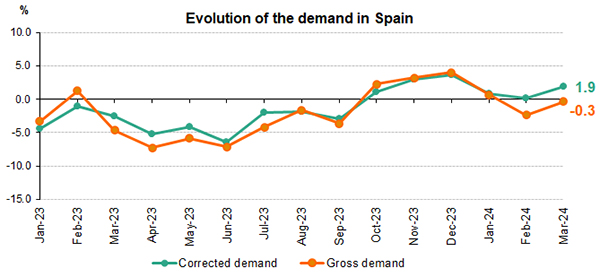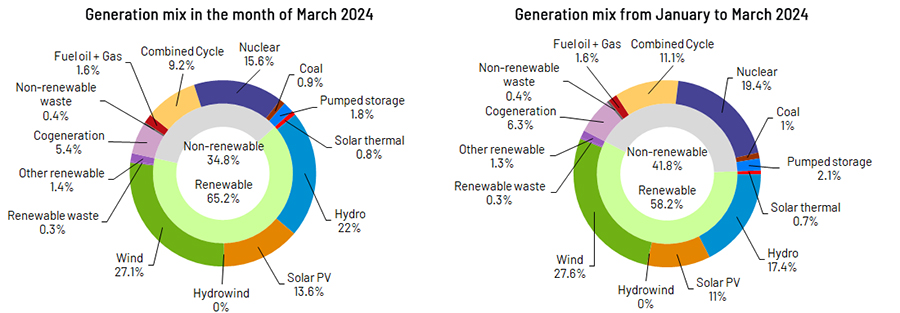- Renewable energy sources reached a monthly production record (14,591 GWh) as well as the highest share of coverage in the electricity mix (65.2%)
- Emission-free generation accounted for 82.2% of total generation and reached its highest share since records began
- For the sixth consecutive month, wind power continued to be the leading source of generation in Spain, with a 27.1% share of total generation in March

Domestic electricity demand increased by 1.9% in March with respect to the same month last year, after adjusting for the effects of temperature and working patterns. This represents an estimated gross demand of 20,413 GWh, 0.3% lower than in March 2023.

In the first quarter of 2024, Spain recorded a total demand of 62,484 GWh, 0.6% less than in the same period of 2023.
This month, renewables reached their highest monthly share in the mix on record, with 14,591 GWh, which accounted for 65.2% of the electricity mix, another all-time high. Production from renewable sources in March saw an increase of 15.6% compared to the same month last year.
According to the provisional data available today, wind power, which generated 27.1% of the total, was the leading technology for the sixth consecutive month, with an output of 6,061 GWh. It is followed by hydro with an output of 4,937 GWh, the highest amount recorded since May 2016. In March, hydro accounted for 22% of total generation in Spain. Solar photovoltaic came in third place among renewable technologies, generating 3,047 GWh in March and representing a 13.6% share.
Overall, emission-free generation reached an all-time high this month, accounting for 82.2% of total generation in Spain.

Peninsular demand increased by 1.6%
Peninsular demand was 1.6% higher than in March 2023, after factoring in the effects of working patterns and temperatures. This March, gross demand reached 19,209 GWh, 0.6% lower than that of the same month the previous year.
For the first three months of the year, peninsular demand stood at 58,935 GWh, 0.8% lower than that recorded for the same period in 2023.
Peninsular renewable energy sources accounted for 67.6% of the total generation in March, according to provisional data available today, which show a production of 14,411 GWh, 16.1% higher than in the same month of the previous year. Emission-free technologies accounted for 85.7% of the total.
In March, the peninsular generation mix was once again led by wind power, which was responsible for 28% of the total, producing 5,969 GWh during the month.
The electricity system in the Balearic and Canary Islands
In the Balearic Islands, electricity demand in March was 7.4% higher than in the same month in 2023, after factoring in the effects of working patterns and temperatures. Gross demand is estimated at 433,166 MWh, 4.5% higher than in March of the previous year. In the first quarter of 2024, gross demand in the Balearic Islands is estimated at 1,284,644 MWh, 1% less than in the same period of 2023.
In terms of generation, combined cycle, which accounted for 68.7% of the energy produced in the Balearic Islands, was the leading source this month. Renewable energy generation without CO2 equivalent emissions in the Balearic Islands accounted for 17.6% of the total, the highest share ever recorded in the archipelago. Renewable energy generation in the Balearic Islands grew by 23.8% in March compared to the same month last year, reaching 56,596 MWh.
In addition, the submarine link between the peninsula and Majorca contributed to meeting 25.6% of the Balearic Islands' electricity demand during the month.
Meanwhile, in the Canary Islands, electricity demand grew by 4.9% compared to the same month in 2023, after factoring in the effects of working patterns and temperatures. Gross demand was 737,266 MWh, representing a 3.6% increase. In the first quarter of 2024, gross demand in the Canary Islands is estimated at 2,169,079 MWh, 4.2% higher than in the same period of 2023.
Regarding electricity generation in the Canary Islands, combined cycle, with 43.8% of the total, was also the leading source in March. Renewable and emission-free technologies reached a share of 16.8% of production, with wind power accounting for 12.4%.
Please see our Daily balance report for further information on the national, peninsular, Balearic Islands and Canary Islands electricity systems up to the end of March.